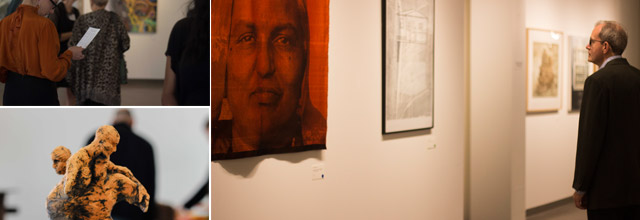
PAULA FROEHLE
Paula Froehle is a film director, visual artist, educator and entrepreneur.
As a filmmaker she has directed 12 films and 20+ media projects. Her directing credits include her feature-length documentary, ÔÇ£The Show Must Go On, An Intimate Portrait of The Flying Wallendas,ÔÇØ which is distributed by MVD Entertainment Group.
As a visual artist she explores new approaches to traditional mediums, most recently blending portraits and stitching to create "floating drawings".
As an entrepreneur she has been involved in the founding of several startups, including Opal Pictures design & film production company; Tribeca Flashpoint Media Arts Academy media arts college (as Founding Academic Dean), and Chicago Media Project, a member-based nonprofit dedicated to supporting impact documentary work and presenting the DOC10 Film Festival each year. She is also co-founder & co-fund manager of CMP Invest/Impact (CMP I/I) one of only two equity funds in the US to invest in documentary films as a "pay it forward" approach in supporting documentary work.
Ms. Froehle received her MFA from the School of the Art Institute of Chicago, and her BFA from the Columbus College of Art and Design. She lives in Chicago with her two grown children, Grace, the artist, and Alexander, the entrepreneur, and Charlotte, their fluffy cockapoo.
Artist Statement
My floating drawings are a tribute to, and meditation on, the traditional practice of mending, sewing, and embroidery, i.e. ÔÇ£womanÔÇÖs workÔÇØ. I have fond memories of my grandmother embroidering napkins and doilies, of my sisters learning to sew, and of my mother mending socks on a lightbulb(!) Each of them never considered their work ÔÇ£artÔÇØ per se, but I choose to see their focused pursuit as the equivalent of any artistÔÇÖs endeavor: to manifest something beautiful, and transformed, through concentrated effort.
As I age, my arthritic fingers turn inward from the rigor of handiwork, and my time becomes less and less my own. I appreciate the moments when all I need is a needle and thread, some tulle, and the sun of a Sunday morning in Chicago.
Late Afternoon in My Studio:
In the heart of the room squats a poppy-red chair, on fire. Draped over its back the noisy Guatemalan blanket, its birds and leaves singing. Pushed hard against the opposite wall, a somber gray couch rumbles like thunder and next to it the circular wooden table rises, as white and wide as the moon.
IÔÇÖm nestled in the palm of the velvet green chair using an old pillowcase as a diary. Stitching images and text with needle and thread, recording the remnants of the day, igniting the studio with its own religion. Out the radioÔÇÖs ear floats a song: ÔÇ£if IÔÇÖve lived the life IÔÇÖm given, I wonÔÇÖt be scared to die.ÔÇØ I grab the line and pin it down into the worn cotton, a mantra for how to move through this world: one foot in front of the other. The words encircle the image of a face peering upward, unsure.
One stitch after another, the needle traps music into the fabric. My hands build a cathedral between me and the cloth. Behind me, silent, rests my first embroidery, created just after the divorce: tiny strands of thread woven into an old undershirt, suspended in a makeshift frame. The sun beats through the fabric to reveal its straggly ends - nests of worry swirl behind the stitched outline of a face - my face, eyes cast downward, brow knit. Above it a silk ribbon with the whisper thin outline of a single word, ÔÇ£endureÔÇØ.
Hours pass, note upon note, the cacophony builds until the cathedral, unable to sustain itself, collapses. The organ comes crashing down, as does the furniture. Poof - the black-eyed susans from the back terrace have disappeared, and the birds have all flown off.
The morning light has pulled back, angling lower through the window. The sliding glass door now closed.
In December this piece will change hands on the eve of an ice storm. The young woman will hold on tightly and for too long when she asks to have it. Months later sheÔÇÖll end her life as the piece sits motionless inside a cardboard box, somewhere in New Jersey.
DEBORAH HIRSHFIELD
Deborah Hirshfield was born and raised in Chicago and Evanston, Illinois and graduated from the American High School in Mexico City, Mexico, after which she studied Dance Theater in New York City, travelled throughout Europe and Israel, and began her career in the textile arts, teaching at the Institute del Arte, San Miguel de Allende, Mexico. Upon her return to the United States, Ms. Hirshfield taught Batik at various North Shore venues.
As a single parent, Ms. Hirshfield matriculated with honors in Art and Music Education from Mundelein College, Chicago and received her Masters in Education from Columbia College, Chicago while her son was in elementary school. After twenty years of encouraging Chicago public schools students PreK-Grade 8 in the arts, she returned to her first career in textile arts.
Ms. Hirshfield has most recently exhibited at Womanmade Gallery, "Adorn," 2015, the Evanston Art Center, "Undefineable," 2017, the Highland Park Art Center, "Voices and Visions," 2016, and "EcoArt," 2017, and Oakton Community College Koehnline Museum, "Nevertheless She Persisted," 2018.
Artist Statement
I am drawn to visual ideas. My work embodies my thoughts on pregnancy, gender, and sexuality. I also have a lifelong love of textiles and their cultural significance. This body of work is centered where ideas and media converge with outrage and humor.
Laurie LeBreton is a sculptor living and working in Chicago. Her primary material is abaca, a paper that she makes herself. She also uses a wide variety of other materials, including yarn, ribbon, beads, aluminum cans, wire and flower petals. Toward the end of a career working with non-profit organizations, she began taking classes in artistsÔÇÖ books. Her interest increased over time, and she eventually decided to go to graduate school.
LeBreton graduated from Columbia College with an MFA in interdisciplinary arts with an emphasis on the book and paper arts. She has exhibited widely in the Chicago area, across the country and internationally. In the fall of 2018 she had two solo shows, at the Robert DeCaprio Gallery at Moraine Valley Community College and at the Lee E. Dulgar Gallery at South Suburban College.
I make sculptures with handmade paper. With these sculptures I try to access something beyond our concrete world and to find meaning and comfort through doing so. Sometimes I do this very directly, as in my piece ÔÇ£A Full Taste of HappinessÔÇØ, an installation of hundreds of Buddha-like sculptures, and at other times indirectly, as in the abstract hanging sculptures I call ÔÇ£Healing Machines.ÔÇØ
For me, paper is the ideal medium to explore these ideas. Paper itself is complex. It is light, responds to movement and appears fragile. As a paper sculptor, I know that it is also pliable, absorbs color beautifully, and is very strong. Abaca, the fiber I use most often, shrinks as it dries, adding the element of chance to all my work. I also enjoy the process of papermaking because of my love of water, for its beauty, sensuality and for its healing qualities.
Working with multiples is a strong component of my work. It is both a metaphor and a strategy. Multiples, especially those with variations, point to the simple yet complicated nature of just about everything. As an artistic strategy, they offer an opportunity for experimentation within a structure, for stillness with many variations. As a visual strategy, they calm a busy eye, with each object informing the others. I often suspend these multiples from the ceiling on fine line. Their movement in response to the movement in the air means that the display itself is impermanent, that it also has many variations.


